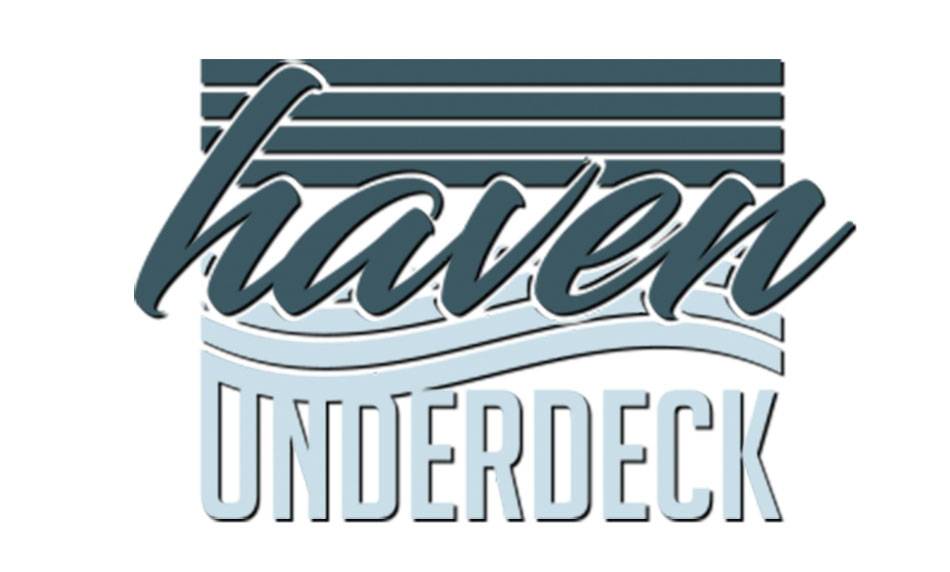Create a Dry, Usable Space Under Your Deck Drainage System
Enjoy a dry deck by installing a drainage system and gutter. Convert wasted space into a valuable extension of your home.
Brands We Offer

Haven Underdeck
Haven Underdeck is your source for an all aluminium constructed underdeck ceiling system. We offer multiple options to fit any budget and design – making the space you envision a reality.
Installing under deck drainage systems allows you to reclaim valuable outdoor living space while protecting your deck’s substructure from moisture damage. Learn how to design an effective underdeck drainage system for a dry, usable area, complete with an under deck ceiling.
Creating an outdoor living space extends your home’s footprint and enhances your property’s functionality and enjoyment. However, the underside of an elevated deck often remains damp and unusable. Excess moisture promotes rot, mold, and decay in deck joists and beams. Proper drainage redirects water away from your deck, while an under deck drainage system, including an under deck ceiling, effectively seals the area from above. This ensures optimum protection, transforming your deck’s underside into a weather-resistant, livable space perfect for storage, parties, or relaxation.
What Are the Benefits of Under Deck Drainage Systems?
An under deck drainage system provides numerous advantages:
- Prevents moisture damage to the deck substructure, extending the life of your deck.
- Creates a dry storage or living space under the deck for year-round use.
- Allows you to install an under deck ceiling, ceiling fans, lighting, and speakers for a finished look.
- Helps control weeds, mud, and lawn damage around the deck area.
- Provides cover for a hot tub, pet area, or garden.
- Reduces the risk of slipping on wet deck stairs by channeling water away.
- Extends enjoyment of outdoor areas by creating usable space regardless of the weather.
Factors to Consider for Your Deck Drainage System
Several considerations factor into designing an effective under deck drainage system:
- Size and layout of the deck.
- Landscaping slope and drainage requirements.
- Local building codes and regulations.
- Desired ceiling height for the covered area.
- Types of activities planned for the space under the deck.
- Aesthetic preferences for the overall look.
Analyze the size, scope, and complexity of your deck to determine the right drainage method. For simple underside protection, consider self-adhering membranes or barrier panels. For larger or elevated decks, opt for a full deck drainage system.
Types of Under Deck Drainage Systems
Deck drainage systems generally fall into two main categories:
Passive Drainage
Passive drainage moves water along the existing slope and structural channels. Options include:
- Landscape grading: Slope the ground under the deck to promote drainage. This is effective for low decks.
- Gravel backfill: Fill the ground under the deck with gravel to disperse humidity.
- Gutter extensions: Use downspout extensions to direct roof runoff away from the deck.
Active Drainage
Active drainage methods use mechanical components to redirect moisture. Choices include:
- Deck dry systems: Lightweight boards with vertical drainage channels attach under joists to direct water away.
- RainEscape systems: PVC troughs mount to joists, connecting with downspouts to manage water flow.
- Channel drains: Linear drains collect and divert water through connected downspouts.
- Sump pumps: Automatically pump water from a sump pit when it accumulates.
- Hybrid drainage systems: Combine passive landscape grading with active mechanical drainage for comprehensive protection.
Installing an Under Deck Ceiling System
An under deck ceiling system provides a finished appearance and a water-resistant covering using interlocking panels. These systems are typically easy to install. Here are the steps to follow:
- Measure the spacing between joists to order the correct panel size.
- Install furring strips if necessary to create a surface for attachment.
- Attach the panels to the joists using clips or screws.
- Interlock the panels and ensure compression seals are tight to prevent leaks.
- Flash the edges with soffit material to ensure proper water flow.
- Install lighting, fans, or speakers for additional functionality.
Under deck ceiling systems are designed for easy access to electrical wiring and typically come with warranties against leaks, condensation, and other issues.
Installing a RainEscape Deck Drainage System
RainEscape systems offer active drainage along the joists. Here’s how to install a RainEscape system:
- Attach specially designed brackets along the joists.
- Mount the drainage channels along the entire joist length.
- Connect the channels using internal connectors.
- Seal the open ends with endcaps.
- Install outlet tubes to direct the water flow to downspouts.
- Flash the perimeter edges for a finished appearance.
RainEscape systems can handle large volumes of water, protecting your deck’s structural integrity.
How Do Channel Drains Work for Deck Drainage?
Channel drains are linear pathways that collect water and direct it away from the deck. Here’s how they function:
- Sloped design: The drains have a sloped, U-shaped body that guides moisture toward the outlet.
- Weep holes: Allow for lateral drainage.
- Removable grates: Prevent debris from clogging the drain.
- Endcaps with outlet ports: Direct water flow to designated areas.
To install channel drains:
- Plan the layout to catch water from the entire deck surface.
- Ensure proper leveling and slope towards the outlets.
- Secure the drains in place using the provided fasteners.
- Join the sections with internal connectors.
- Seal the edges to prevent leaks.
Lighting Considerations for Under Deck Spaces
Adding lighting to an under deck ceiling transforms the area into a pleasant, functional space. Consider:
- Local electrical codes for safe outdoor wiring.
- Fastening points for lights and fans.
- Brightness and color temperature for the desired ambiance.
- Dimmer switches for adjustable lighting control.
- Potential glare issues from certain types of lighting.
Options include:
- Recessed can lights for general illumination.
- LED tape lighting for accent lighting along the joists.
- Floodlights or lanterns for brighter illumination.
- Battery-operated fairy lights for decorative effects.
Creative Ways to Use Under Deck Space
With an under deck drainage system and ceiling, you can transform the space into:
- A lounging area with patio furniture.
- A bistro dining nook with added privacy.
- A hot tub enclosure for year-round enjoyment.
- Storage space for seasonal furniture.
- A pet grooming area or garden workspace.
- An enclosed area for smoking or outdoor activities.
- A playhouse or fort for kids.
- A nursery for plants or seedlings.
- A workshop or crafting zone.
- An extra entertaining space for hosting parties.
Key Takeaways for Deck Drainage Systems
- Protect your deck’s substructure from moisture and prevent long-term damage.
- Passive drainage uses ground grading and downspout extensions, while active systems like RainEscape and channel drains offer robust protection.
- Properly install under deck ceiling systems to create a weather-resistant area.
- Enhance the under deck space with lighting, flooring, and furniture for a comfortable living area.
- Enjoy your outdoor space in any weather by utilizing under deck drainage systems.
Looking to get started on your deck design and build? Contact us today for professional assistance.
Visit our website to find the nearest location, or connect with a deck designer.
Follow us on Facebook and Instagram for more ideas on deck drainage systems and outdoor living solutions.
